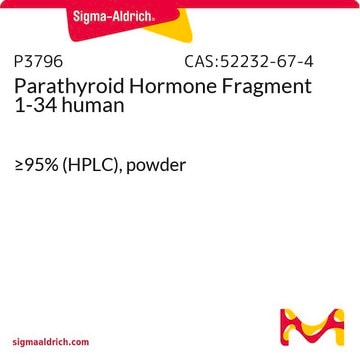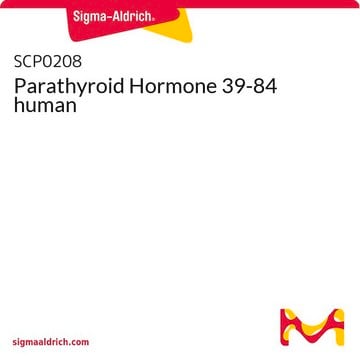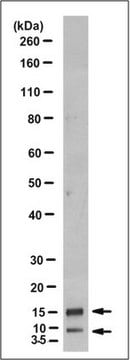H9148
Hypercalcemia of malignancy factor fragment 1-34 amide human
≥97% (HPLC)
Synonim(y):
Ala-Val-Ser-Glu-His-Gln-Leu-Leu-His-Asp-Lys-Gly-Lys-Ser-Ile-Gln-Asp-Leu-Arg-Arg-Arg-Phe-Phe-Leu-His-His-Leu-Ile-Ala-Glu-Ile-His-Thr-Ala-NH2, PTHrP (1-34) amide, Parathyroid hormone-related protein (1-34) Amide
About This Item
Polecane produkty
Poziom jakości
Próba
≥97% (HPLC)
Postać
solid
metody
drug transporter assay: suitable
kolor
white
numer dostępu UniProt
temp. przechowywania
−20°C
ciąg SMILES
CC[C@H](C)[C@H](NC(=O)[C@H](CC(C)C)NC(=O)[C@H](Cc1c[nH]cn1)NC(=O)[C@H](Cc2c[nH]cn2)NC(=O)[C@H](CC(C)C)NC(=O)[C@H](Cc3ccccc3)NC(=O)[C@H](Cc4ccccc4)NC(=O)[C@H](CCCNC(N)=N)NC(=O)[C@H](CCCNC(N)=N)NC(=O)[C@H](CCCNC(N)=N)NC(=O)[C@H](CC(C)C)NC(=O)[C@H](CC(O)=O)NC(=O)[C@H](CCC(N)=O)NC(=O)[C@@H](NC(=O)[C@H](CO)NC(=O)[C@H](CCCCN)NC(=O)CNC(=O)[C@H](CCCCN)NC(=O)[C@H](CC(O)=O)NC(=O)[C@H](Cc5c[nH]cn5)NC(=O)[C@H](CC(C)C)NC(=O)[C@H](CC(C)C)NC(=O)[C@H](CCC(N)=O)NC(=O)[C@H](Cc6c[nH]cn6)NC(=O)[C@H](CCC(O)=O)NC(=O)[C@H](CO)NC(=O)[C@@H](NC(=O)[C@H](C)N)C(C)C)[C@@H](C)CC)C(=O)N[C@@H](C)C(=O)N[C@@H](CCC(O)=O)C(=O)N[C@@H]([C@@H](C)CC)C(=O)N[C@@H](Cc7c[nH]cn7)C(=O)N[C@@H]([C@@H](C)O)C(=O)N[C@@H](C)C(N)=O
InChI
1S/C180H288N58O47/c1-23-94(16)141(174(282)208-99(21)147(255)210-116(51-55-137(247)248)156(264)235-143(96(18)25-3)176(284)231-128(72-107-79-197-87-206-107)170(278)238-144(100(22)241)177(285)207-98(20)145(186)253)236-169(277)121(65-92(12)13)222-164(272)125(69-104-76-194-84-203-104)228-165(273)126(70-105-77-195-85-204-105)226-160(268)120(64-91(10)11)220-161(269)123(67-102-41-30-27-31-42-102)224-162(270)122(66-101-39-28-26-29-40-101)223-152(260)112(47-38-60-200-180(191)192)213-150(258)110(45-36-58-198-178(187)188)212-151(259)111(46-37-59-199-179(189)190)214-157(265)117(61-88(4)5)221-168(276)130(74-139(251)252)229-154(262)114(49-53-134(185)243)217-175(283)142(95(17)24-2)237-172(280)132(82-240)232-149(257)109(44-33-35-57-182)209-135(244)80-201-148(256)108(43-32-34-56-181)211-167(275)129(73-138(249)250)230-166(274)127(71-106-78-196-86-205-106)227-159(267)119(63-90(8)9)219-158(266)118(62-89(6)7)218-153(261)113(48-52-133(184)242)215-163(271)124(68-103-75-193-83-202-103)225-155(263)115(50-54-136(245)246)216-171(279)131(81-239)233-173(281)140(93(14)15)234-146(254)97(19)183/h26-31,39-42,75-79,83-100,108-132,140-144,239-241H,23-25,32-38,43-74,80-82,181-183H2,1-22H3,(H2,184,242)(H2,185,243)(H2,186,253)(H,193,202)(H,194,203)(H,195,204)(H,196,205)(H,197,206)(H,201,256)(H,207,285)(H,208,282)(H,209,244)(H,210,255)(H,211,275)(H,212,259)(H,213,258)(H,214,265)(H,215,271)(H,216,279)(H,217,283)(H,218,261)(H,219,266)(H,220,269)(H,221,276)(H,222,272)(H,223,260)(H,224,270)(H,225,263)(H,226,268)(H,227,267)(H,228,273)(H,229,262)(H,230,274)(H,231,284)(H,232,257)(H,233,281)(H,234,254)(H,235,264)(H,236,277)(H,237,280)(H,238,278)(H,245,246)(H,247,248)(H,249,250)(H,251,252)(H4,187,188,198)(H4,189,190,199)(H4,191,192,200)/t94-,95-,96-,97-,98-,99-,100+,108-,109-,110-,111-,112-,113-,114-,115-,116-,117-,118-,119-,120-,121-,122-,123-,124-,125-,126-,127-,128-,129-,130-,131-,132-,140-,141-,142-,143-,144-/m0/s1
Klucz InChI
YUTJVTMXUNTCEG-WBTWNKCNSA-N
informacje o genach
human ... PTHLH(5744)
Powiązane kategorie
Amino Acid Sequence
Działania biochem./fizjol.
Inne uwagi
Kod klasy składowania
11 - Combustible Solids
Klasa zagrożenia wodnego (WGK)
WGK 3
Temperatura zapłonu (°F)
Not applicable
Temperatura zapłonu (°C)
Not applicable
Środki ochrony indywidualnej
Eyeshields, Gloves, type N95 (US)
Certyfikaty analizy (CoA)
Poszukaj Certyfikaty analizy (CoA), wpisując numer partii/serii produktów. Numery serii i partii można znaleźć na etykiecie produktu po słowach „seria” lub „partia”.
Masz już ten produkt?
Dokumenty związane z niedawno zakupionymi produktami zostały zamieszczone w Bibliotece dokumentów.
Nasz zespół naukowców ma doświadczenie we wszystkich obszarach badań, w tym w naukach przyrodniczych, materiałoznawstwie, syntezie chemicznej, chromatografii, analityce i wielu innych dziedzinach.
Skontaktuj się z zespołem ds. pomocy technicznej





